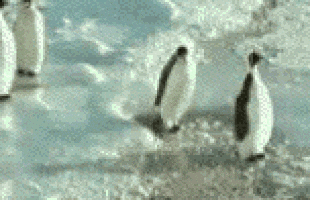- Sustainability Writer
- Posts
- Antarctica is having a meltdown
Antarctica is having a meltdown
Cold truths and harsh realities of Antarctica's disappearing act.

Hi friend,
My husband has taken up spearfishing since we moved to Australia. The first time he brought home a catch, he made the rookie error of chucking the fish guts into the outside bin.
In the middle of summer.
Five days before bin day.
It was a lesson hard learned and we now have the foresight to freeze the fish guts and dump them on rubbish collection day.
It’s on those in-between days that I appreciate the wonderful invention that is a freezer and how we can preserve things for longer than we probably should.
(Case in point: In Sydney, families are freezing dirty nappies after councils reduced bin collection from once a week to once every two weeks. Now, that’s shit.)
Some things, once frozen, should stay that way forever.
Like fish guts, poopy nappies, and the ice sheets in Antarctica. But they’re not.
In fact, Antarctic sea ice hit an all-time low in February this year.
Between 1997 and 2021, the continent, a critical regulator of Earth’s climate, lost an eye-watering 7.5 TRILLION metric tonnes of ice. That’s about the weight of five million cars.
Or 50,000 blue whales.
Or 1.25 million elephants.
Disappearing sea ice is a problem for many reasons, with consequences far beyond just a bad smell and serious environmental impacts.
The overlooked problem of sub-glacial discharge
Sub-glacial discharge – the flow of meltwater from beneath glaciers into the ocean – could be causing a faster rate of ice loss than previously estimated. The impact of sub-glacial discharge is often overlooked, but scientists are now warning of the profound implications.
As ice erodes from underneath the glaciers, freshwater is released into the ocean, which disrupts the currents.
That’s a problem because ocean currents are the pulse of the planet
The influx of freshwater from melting glaciers decreases the salinity and density of seawater, which slows down the Southern Ocean’s currents.
These currents move heat, carbon, oxygen, and vital nutrients around the globe, and their disruption impacts weather patterns, fisheries, and ecosystems worldwide.
At the current (*cough*) rate of carbon emissions, currents could slow down by 40%, affecting the ocean's ability to absorb carbon, leading to even warmer oceans.
That’s a problem because warm oceans = rising seas
Water from melted ice absorbs more heat than ice does. So, not only does the water not re-freeze, but warm water also expands, which increases sea levels.
In fact, melting ice accounted for almost 18% of the total global sea level rise between 2012 and 2017, and could increase sea levels by 15% by 2300.
Fun fact: If the entire Antarctic ice sheet melts (which is unlikely but not impossible at the rate we’re going), it could raise sea levels by around 58 metres.
That’s a problem because rising seas threaten coastal communities…
Glaciers store about 70% of the Earth’s freshwater. When they melt, they threaten water supplies for up to two billion people living in coastal areas. The ice lost between 1997 and 2021 could have supplied 3.75 billion people with drinking water for a day.
Melting glaciers also increase the risk of extreme weather events, like floods and fires. Changes in the cryosphere (Earth’s frozen bits) can alter circulation patterns in the atmosphere, leading to extreme snow and rainfall, which can cause flash floods and glacial lake outbursts.
Scientists warn that the homes of up to 410 million people living in coastal areas and on low-lying islands could be affected by an increasing frequency of flooding resulting from rising seas by 2100.
… and penguins
Melting sea ice is also disrupting breeding patterns of emperor penguins, threatening to wipe out entire populations by 2100. Record low sea ice levels in 2022 coincided with the first-ever recorded large-scale breeding failure of emperor penguins. Coincidence? I think not.
It’s not just the penguins that are under threat – up to two-thirds of Antarctica’s native species face extinction or major population declines by the end of the century.
The melting iceberg effect
In a natural cycle, there’d be periods of ice shelf shrinkage followed by slow regrowth. But more than 40% of Antarctica’s ice shelves have been steadily shrinking since 1997, with almost half showing no sign of recovery. That’s because the continent is warming at nearly twice the rate of the rest of the world, with temperatures increasing by almost 3°C over the past 50 years.
Once the ice in West Antarctica begins to disintegrate, scientists say it will gain momentum and be difficult - if not impossible - to reverse within a human lifetime. They’ve also warned that 93% of Earth’s near-surface permafrost could disappear by 2100, which would have a profound impact on human livelihood, infrastructure, the global carbon cycle, and water systems.
When once-frozen ground defrosts, it not only releases trapped greenhouse gases but also viruses, bacteria, and organic material that has been lying dormant for hundreds of thousands of years and that we know little about. And fish guts. Lots and lots of fish guts.
But that’s a story for another newsletter.
— Tarryn ✌️
P.S. Did someone forward this to you? You can subscribe here and get it straight in your inbox.
This week's climate and sustainability news worth noting
❌ Countries’ current plans to reduce their carbon emissions would actually increase global emissions by 8.8% by 2030 compared to 2010 levels, according to a new United Nations report.
🥵 Global temperatures from now through 2024 are predicted to be “unprecedented” as the current El Niño phase looks likely to be one of the strongest on record. A comparison of the most recent 17 El Niño events shows the 2023 edition was the sixth strongest to October.
🤝 The US and China announced an agreement to sharply increase clean energy, displace fossil fuels, and reduce emissions. Both countries have agreed to “pursue efforts to triple renewable energy capacity globally by 2030” and to achieve “meaningful absolute power sector emission reduction”. Although a step in the right direction, China stopped short of promising to phase out its heavy use of coal or to stop permitting and building new coal plants; however, it did agree to set reduction targets for all greenhouse gas emissions.
🇺🇸 The US has released the Fifth National Climate Assessment, a landmark federal report emphasising the unequal impact of climate change in the US. It's the first National Climate Assessment to heavily focus on environmental justice, highlighting that low-income families and communities of colour suffer the most from environmental harms while benefiting least from environmental regulation. To address these issues, the administration announced US$6 billion in federal investments for flood risk reduction, environmental justice, and strengthening the US electric grid. This year’s report also focused on the importance of Indigenous knowledge and agriculture’s contribution to climate change.
🏥 A report published by an international team of 114 researchers has warned that climate change is having a worsening effect on health and mortality around the world, with babies and the elderly most at risk. Heat-related deaths of people over 65 increased by 85% since the 1990s. Climate change has also led to income losses and severe food insecurity, and researchers warn that if the global average temperature rises by 2C, the number of heat-related deaths each year will increase by 370% by 2050. There is some good news. Deaths from air pollution related to fossil fuels have decreased by 15% since 2005, thanks to a decrease in fossil fuel emissions.
🇦🇺 Last week, thousands of schoolchildren across Australia took a sick day to protest for a sick planet, supported by “climate doctors” and scientists who wrote a special sick note for the day. The letter states the student is “unfit [for school] due to a major climate health concern”, noting their “elevated stress” and “feelings of despair” on seeing the impacts of climate change. This is the fifth year that school students have downed pens and books to demand greater action on climate change. Meanwhile, Australia has joined the Measurement, Monitoring, Reporting and Verification (MMRV) group, an international working group to measure and verify greenhouse gas emissions across international supply chains.
🌺 The Kealia pond in Hawaii turned bubblegum pink due to the presence of halobacteria – an indicator of environmental stress. Halobacteria thrives in bodies with high levels of salt. The salinity in the pond is 70 parts per thousand – twice the salinity of seawater – making it too high for fish to survive and other animals to drink. This phenomenon usually occurs in dry areas. The fact that it’s happening in Hawaii, which has a generally humid climate, is a sign that the ecology of the area is greatly distressed and speaks to more extreme weather events resulting from climate change.
🔥 Climate change is making wildfires more frequent and intense, but a new study has found that controlled burning, or prescribed burns, can cut the risk of high-intensity fires by 64%. The intentional use of controlled fires helps to clear out natural debris, vegetation, and other fuel, which if left to accumulate, can fan the flames of larger blazes. Indigenous people have used controlled burning for centuries as an effective forest management technique, but this study is proof that low-intensity fires can reduce the risk of high-intensity fires by 64% and provide some degree of protection for at least six years, which could strengthen forest resilience and reduce catastrophic wildfires fanned by climate change.
🧴 The costs of plastic across its lifecycle — from production to disposal — are at least eight times higher for low- and middle-income countries than they are for high-income countries. The World Wide Fund for Nature says the developing world is disproportionately impacted by plastic production through toxic air emissions, land and water pollution, chemical spills, and overwhelmed waste management infrastructure. The report comes as delegates meet in Nairobi, Kenya, for a third round of negotiations on a global plastics treaty to reduce plastic pollution and fund waste management in the developing world.
And in business news
🛢️ A judge has ruled that the massive ConocoPhillips Willow oil project in Alaska can go ahead. The project will be the largest oil development on US federal land in decades.
📦 Amazon has switched to recyclable paper and card delivery packaging for all orders delivered in Europe. Amazon has now mitigated the use of more than a billion single-use plastic delivery bags from its European distribution since 2018.
One small thing you can do
Don’t idle your car.
If you have a petrol or diesel vehicle, switch off the engine when you pull over, when you’re waiting for the kids outside school, or even when stopping at a traffic light that tales forever to change.
It’s an easy way to reduce your personal carbon emissions and make an immediate improvement to local air quality.
Because lots of little actions combined can add up to something remarkable.
I'll leave you on this happy note...
Bless you 🤧
Enjoyed this newsletter? Please subscribe and tell your friends about it ✌️






